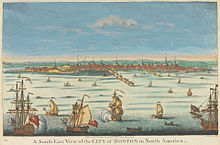| 1721 Boston smallpox epidemic | |
|---|---|
 | |
| Disease | Smallpox |
| Virus strain | Variola major |
| Location | Boston, Massachusetts |
| Index case | British sailor disembarking HMS Seahorse [1][2] |
| Dates | 22 April 1721 - 22 February 1722 |
| Confirmed cases | 5,759 [3] |
Deaths | 844 [4][3] |
In 1721, Boston experienced its worst outbreak of smallpox (also known as variola). 5,759 people out of around 10,600[5] in Boston were infected and 844 were recorded to have died between April 1721 and February 1722.[4][3] The outbreak motivated Puritan minister Cotton Mather and physician Zabdiel Boylston to variolate hundreds of Bostonians as part of the Thirteen Colonies' earliest experiment with public inoculation. Their efforts would inspire further research for immunizing people from smallpox, placing the Massachusetts Bay Colony at the epicenter of the Colonies' first inoculation debate and changing Western society's medical treatment of the disease. The outbreak also altered social and religious public discourse about disease, as Boston's newspapers published various pamphlets opposing and supporting the inoculation efforts.
- ^ Cite error: The named reference
farmerwas invoked but never defined (see the help page). - ^ Cite error: The named reference
Cosswas invoked but never defined (see the help page). - ^ a b c Cite error: The named reference
thatcherwas invoked but never defined (see the help page). - ^ a b Kelly, M.D., Howard; Burrage, M.D., Walter (1920). American Medical Biographies. The Norman, Remington Company. p. 134. Retrieved 15 June 2019.
- ^ Cite error: The named reference
buhrwas invoked but never defined (see the help page).